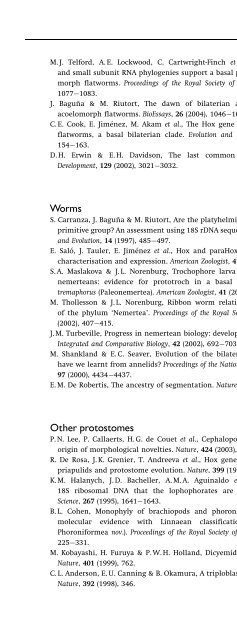- Page 2:
This page intentionally left blank
- Page 10:
cambridge university pressCambridge
- Page 14:
viCONTENTS4.5 What is the ecologica
- Page 18:
viiiCONTENTS13.5 What are the speci
- Page 24:
Boxes5.1 Muscle page 495.2 Protosto
- Page 30:
xivPREFACEfirst two, are more gener
- Page 36:
Illustration acknowledgementsAll th
- Page 40:
Chapter1The process of evolution:na
- Page 44:
WHAT IS THE CELLULAR BASIS OF HERED
- Page 48:
WHAT IS THE ORIGIN OF GENETIC VARIA
- Page 52:
WHAT IN GENERAL DOES EVOLUTION PROD
- Page 56:
WHAT IN GENERAL DOES EVOLUTION PROD
- Page 60:
Chapter 2The pattern of evolution:m
- Page 64:
HOW CAN WE USE MORPHOLOGY TO TRACE
- Page 68:
HOW CAN WE USE FOSSILS TO INVESTIGA
- Page 72:
CAN THE FOSSIL RECORD DATE THE EARL
- Page 76:
WHICH MOLECULES ARE USED?19Using pa
- Page 80:
HOW RELIABLE IS MOLECULAR TAXONOMY?
- Page 84:
Chapter 3PoriferaSponges are by far
- Page 88:
WHAT DIFFERENT KINDS OF SPONGE ARE
- Page 92:
HOW DO SPONGES MAKE A LIVING?27dige
- Page 96:
WHAT CHANGES HAVE EVOLVED DURING SP
- Page 100:
HOW HAVE SPONGES BECOME SO SUCCESSF
- Page 104:
WHY DO WE REGARD CNIDARIA AS SIMPLE
- Page 108:
HOW DO CNIDARIA MAKE A LIVING?35Fig
- Page 112:
HOW DO CNIDARIA MAKE A LIVING?37Nem
- Page 116:
HOW DO CNIDARIA MAKE A LIVING?39of
- Page 120:
HOW HAS SO MUCH DIVERSITY BEEN POSS
- Page 124:
WHATISTHEECOLOGICALIMPORTANCEOFCORA
- Page 128:
HOW ARE CNIDARIA RELATED TO EACH OT
- Page 132:
Chapter 5On being a wormAny soft-bo
- Page 136:
MUSCLE49Box 5.1MuscleMuscles contra
- Page 140:
MUSCLE51divided into coelomates, ps
- Page 144:
MUSCLE53Fig. 5.1 (contd.) (c) Thene
- Page 148:
WHAT WORM PHYLA ARE KNOWN?55Fig. 5.
- Page 152:
WHAT WORM PHYLA ARE KNOWN?57Fig. 5.
- Page 156:
WHAT WORM PHYLA ARE KNOWN?59conspic
- Page 160:
PROTOSTOMES AND DEUTEROSTOMES61Clea
- Page 164:
DO CTENOPHORA BELONG AMONG THE WORM
- Page 168:
Chapter 6Platyhelminthes andAcoelom
- Page 172:
WHATARE THE ACOELOMORPHA?67Parasiti
- Page 176:
WHAT IS SPECIALISED ABOUT MODERN PL
- Page 180:
PARASITISM71Box 6.1ParasitismParasi
- Page 184:
HOW ARE PLATYHELMINTHS RELATED TO O
- Page 188:
Chapter 7NemerteaNemertea (also cal
- Page 192:
WHATARE THE PRINCIPAL GROUPS OF NEM
- Page 196:
HOW DO NEMERTINES DIFFER FROM PLATY
- Page 200:
HOW DO NEMERTINES DIFFER FROM PLATY
- Page 204:
HOW DO NEMERTINES DIFFER FROM PLATY
- Page 208:
HOW DO NEMERTINES DEVELOP?85Fig. 7.
- Page 212:
SEA, FRESH WATER AND LAND87Box 7.1S
- Page 216:
SEA, FRESH WATER AND LAND892. Activ
- Page 220:
HOW ARE THESE CHARACTERS RELATED TO
- Page 224:
HOW ARE THESE CHARACTERS RELATED TO
- Page 228:
WHYARE NEMATODES USEFUL FOR DEVELOP
- Page 232:
WHY HAS CAENORHABDITIS ELEGANS BEEN
- Page 236:
HOW ARE NEMATODES RELATED TO OTHER
- Page 240:
Chapter 9AnnelidaMost of the 15 000
- Page 244:
EXCRETION103Excretory productsOther
- Page 248:
WHATARE THE ADVANTAGES OF THE COELO
- Page 252:
WHATARE THE ADVANTAGES OF THE COELO
- Page 256:
RESPIRATION109The overall equation
- Page 260:
TRANSPORT SYSTEMS111lobes with a la
- Page 264:
TRANSPORT SYSTEMS113Oxygen dissocia
- Page 268:
HOW DO ANNELIDS REPRODUCE AND FEED?
- Page 272:
HOW ARE ANNELIDS RELATED TO EACH OT
- Page 276:
HOW ARE ANNELIDS RELATED TO OTHER P
- Page 280:
HOW CAN SUCH AN ANIMAL FUNCTION?121
- Page 284:
WHAT IS THE SHELL AND HOW MAY IT BE
- Page 288:
WHAT ARE THE ACULIFERA?125calcareou
- Page 292:
HOW IS THE MOLLUSCAN BODY PLAN MODI
- Page 296:
HOW IS THE MOLLUSCAN BODY PLAN MODI
- Page 300:
HOW MAYGASTROPODS FEED?131Fig.10.6
- Page 304:
CONCLUSION133especially in the sea.
- Page 308:
Chapter11Mollusca: Bivalvia andCeph
- Page 312:
HOW DO BIVALVES FEED?137The activit
- Page 316:
HOW IS THE MOLLUSCAN BODY PLAN MODI
- Page 320:
WHAT CEPHALOPODS ARE KNOWN?141Fig.1
- Page 324:
BUOYANCY143thereismore food.Buoyanc
- Page 328:
HOW HAVE SOME CEPHALOPODS BECOME SO
- Page 332:
NERVES AND BRAINS147knowledge about
- Page 336:
NERVES AND BRAINS149(e) The relatio
- Page 340:
WHAT HAS LIMITED THE EVOLUTION OF C
- Page 344:
Chapter12Arthropoda: generalArthrop
- Page 348:
WHATARE THE KEY FEATURES OF ARTHROP
- Page 352:
WHATARE THE KEY FEATURES OF ARTHROP
- Page 356:
WHATARE THE KEY FEATURES OF ARTHROP
- Page 360:
WHAT MAKES POSSIBLE THE GREATACTIVI
- Page 364:
WHAT MAKES POSSIBLE THE GREATACTIVI
- Page 368:
WHATARE THE CLOSEST RELATIONS OF AR
- Page 372:
WHATARE THE CLOSEST RELATIONS OF AR
- Page 376:
WHAT ARE THE MAIN KINDS OF CRUSTACE
- Page 380:
HOW HAVE CRUSTACEANS COLONISED FRES
- Page 384:
HOW HAVE CRUSTACEANS COLONISED FRES
- Page 388:
HOW HAVE CRUSTACEANS COLONISED FRES
- Page 392:
WHATARE THE SPECIAL FEATURES OF PAR
- Page 396:
WHAT IS THE ROLE OF CRUSTACEAN LARV
- Page 400:
Chapter14Chelicerata and MyriapodaC
- Page 404:
WHY IS LIMULUS OF SPECIAL INTEREST?
- Page 408:
WHATARE ARACHNIDS?18514.4 What are
- Page 412:
HOW DID ARACHNIDS COLONISE THE LAND
- Page 416:
WHATARE MYRIAPODS AND HOW DOTHEY MO
- Page 420:
HOW WELL ARE MYRIAPODS ADAPTED TO L
- Page 424:
WHYARE INSECTS SUCH SUCCESSFUL LAND
- Page 428:
HOW ARE INSECTS ABLE TO FLY?195mid
- Page 432:
HOW ARE INSECTS ABLE TO FLY?197Fig.
- Page 436:
HOW ARE INSECTS ABLE TO FLY?19915.3
- Page 440:
WHAT IS DISTINCTIVE ABOUT INSECT LI
- Page 444:
WHATARE THE MAIN ORDERS OF INSECTS?
- Page 448:
WHATARE THE MAIN ORDERS OF INSECTS?
- Page 452:
WHATARE THE MAIN ORDERS OF INSECTS?
- Page 456:
HOW COULD SOCIAL BEHAVIOUR HAVE EVO
- Page 460:
WHY HAS STUDY OF THE FRUIT FLY DROS
- Page 464:
Chapter16Animals with lophophoresSe
- Page 468:
WHICH ANIMALS HAVE LOPHOPHORES?215o
- Page 472:
ARE ANIMALS WITH LOPHOPHORES PROTOS
- Page 476:
SHOULD THERE BE A GROUP CALLED ‘L
- Page 480:
HOW ANIMALS FEED221Intake of plant
- Page 484:
WHAT IS UNIQUE ABOUT ECHINODERMS?22
- Page 488:
HOW DO DIFFERENT ECHINODERMS FEED A
- Page 492:
HOW DO DIFFERENT ECHINODERMS FEED A
- Page 496:
HOW DO DIFFERENT ECHINODERMS FEED A
- Page 500:
HOW DO DIFFERENT ECHINODERMS FEED A
- Page 504:
DO THE LARVAE ILLUMINATE ECHINODERM
- Page 508:
LARVAE235Why have a larva?Early hat
- Page 512:
WHAT ARE THE CHORDATE CHARACTERS?23
- Page 516:
WHICH ARE THE INVERTEBRATE CHORDATE
- Page 520:
WHAT ARE THE HEMICHORDATES?241the v
- Page 524:
WHAT DO ENTEROPNEUSTS AND PTEROBRAN
- Page 528:
DEEP-SEA INVERTEBRATES245the lophop
- Page 532:
Chapter19DevelopmentDevelopment of
- Page 536:
WHAT IS THE PATTERN OF CLEAVAGE IN
- Page 540:
WHAT IS THE PATTERN OF CLEAVAGE IN
- Page 544:
HOW DO INVERTEBRATES GASTRULATE?253
- Page 548:
HOW DO CELLS ACQUIRE POSITIONAL INF
- Page 552:
HOW DO GENES REGULATE DEVELOPMENT?2
- Page 556:
WHATARE HOX GENES AND HOW DO THEY W
- Page 560:
CONCLUSION261conserved, but their e
- Page 564:
Chapter 20Invertebrate evolutionary
- Page 568: WHAT DO GENES TELL US ABOUT RELATIO
- Page 572: HOW DO GENES RELATE THE PROTOSTOME
- Page 576: HOW DO GENES RELATE THE PROTOSTOME
- Page 580: WHERE DO THE SMALLER PROTOSTOME PHY
- Page 584: HOW DO GENES RELATE THE DEUTEROSTOM
- Page 588: HOW DO GENES RELATE THE DEUTEROSTOM
- Page 592: WHAT DO MOLECULES TELLUS ABOUT RELA
- Page 596: WHAT DO MOLECULES TELLUS ABOUT RELA
- Page 600: CAN WE NOW DEFINE HOMOLOGY?281eye d
- Page 604: Further readingThe second edition o
- Page 608: FURTHER READING285G. E. Budd & S. J
- Page 612: FURTHER READING287Annelida (Chapter
- Page 616: FURTHER READING289C. T. S. Little &
- Page 622: 292 FURTHER READINGA. S. Monteiro,
- Page 626: GlossaryWords in italic have their
- Page 630: 296 GLOSSARYBuoyancy Neutral buoyan
- Page 634: 298 GLOSSARYDepolarisation Applied
- Page 638: 300 GLOSSARYGamete The haploid unit
- Page 642: 302 GLOSSARYIntrovert Front end of
- Page 646: 304 GLOSSARYMitosis Division of the
- Page 650: 306 GLOSSARYOssicle Skeletal unit o
- Page 654: 308 GLOSSARYRadial cleavage Cleavag
- Page 658: 310 GLOSSARYTagma Region of an arth
- Page 664: IndexBold numbers denote figures an
- Page 668: INDEX315model animal 3, 192, 210-12
- Page 672:
INDEX317in chordates 237, 238, 240h
- Page 676:
INDEX319Tail 236, 237, 240, Fig. 18











